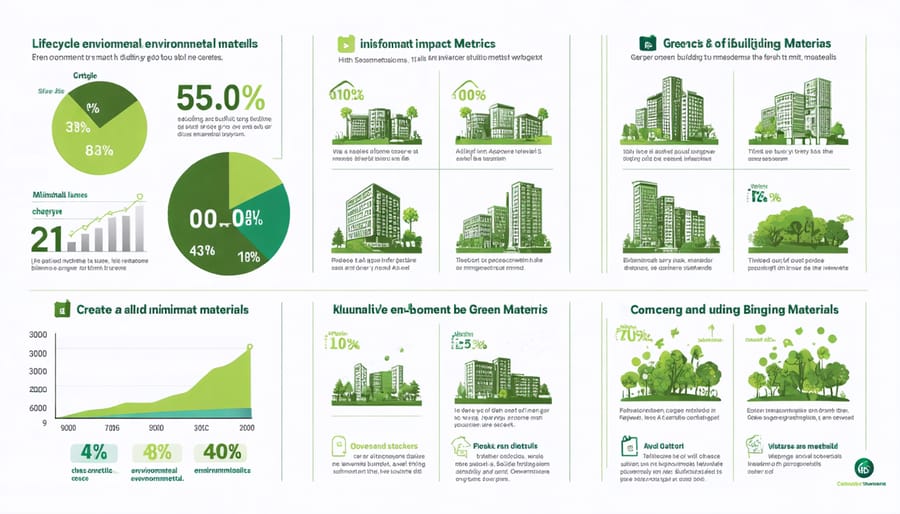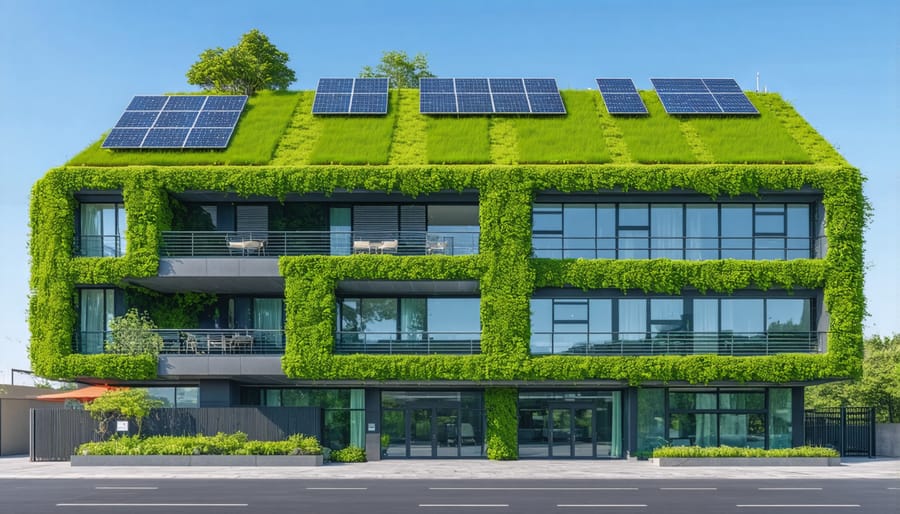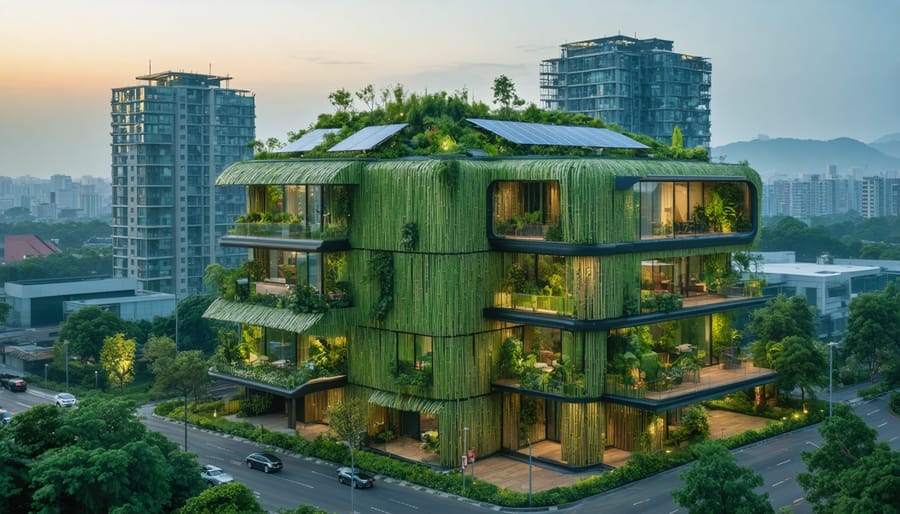Green building materials represent a cornerstone of modern sustainable construction, fundamentally transforming how we approach building design and implementation. These materials encompass renewable, recycled, or low-environmental-impact products that significantly reduce a structure’s carbon footprint while maintaining exceptional performance standards.
From rapidly renewable bamboo flooring to recycled steel beams, and from low-VOC finishes to carbon-sequestering hempcrete, green building materials deliver robust solutions for today’s construction challenges. They meet rigorous performance criteria while addressing critical environmental concerns such as resource depletion, carbon emissions, and waste reduction.
Industry professionals increasingly recognize these materials as essential components in achieving LEED certification and meeting stringent environmental regulations. Recent advancements in material science have elevated their durability and cost-effectiveness, making them not just environmentally responsible choices, but economically viable alternatives to traditional building materials.
This comprehensive analysis examines the most effective green building materials available today, their performance metrics, implementation strategies, and their role in creating resilient, future-proof structures that meet both environmental standards and client expectations.
Defining Green Building Materials

Core Characteristics
Green building materials are defined by several fundamental characteristics that distinguish them from conventional construction materials. These materials must demonstrate low environmental impact throughout their lifecycle, from extraction to disposal. Recyclability is a crucial attribute, with materials either containing recycled content or being fully recyclable at the end of their useful life.
Renewable sourcing is another essential characteristic, with materials derived from rapidly renewable resources or sustainably managed sources. This includes materials that can be replenished within a 10-year cycle or less. The manufacturing process must exhibit minimal energy consumption and low carbon emissions compared to traditional alternatives.
Durability and longevity are paramount, as longer-lasting materials reduce replacement frequency and associated environmental impacts. Non-toxic composition is equally important, ensuring materials are free from volatile organic compounds (VOCs) and other harmful substances that could affect indoor air quality or environmental health.
Local availability is also considered a core characteristic, as materials sourced within regional boundaries reduce transportation emissions and support local economies. Additionally, these materials should demonstrate resource efficiency, utilizing minimal raw materials while maintaining optimal performance standards.
Certification Standards
Several widely recognized certification systems establish standards for green building materials, ensuring their environmental performance and sustainability credentials. LEED (Leadership in Energy and Environmental Design), administered by the U.S. Green Building Council, remains the most prominent system globally, evaluating materials based on environmental product declarations, sourcing practices, and material ingredients.
The BREEAM (Building Research Establishment Environmental Assessment Method) certification, prevalent in Europe, focuses on material lifecycle assessment and responsible sourcing. Living Building Challenge (LBC) maintains stringent requirements through its Red List, which identifies prohibited chemicals and materials in construction.
Cradle to Cradle (C2C) certification specifically evaluates building materials across five categories: material health, material reuse, renewable energy use, water stewardship, and social fairness. Green Globes offers a comprehensive assessment system that emphasizes material selection based on environmental impact and durability.
These certification systems typically require documentation of material sourcing, manufacturing processes, chemical composition, and environmental impacts. Many also consider factors such as recycled content, regional materials, rapidly renewable resources, and third-party verification of environmental claims.
Categories of Green Building Materials

Recycled Materials
Recycled materials represent a cornerstone of sustainable construction, transforming waste products into valuable building resources. Steel, concrete, and glass are among the most commonly recycled materials, with recycled steel achieving up to 95% energy savings compared to virgin material production. Post-consumer recycled glass can be processed into terrazzo flooring or decorative surfaces, while crushed concrete serves as aggregate in new concrete mixtures, reducing landfill waste.
Innovative applications include recycled plastic lumber for decking and outdoor structures, offering superior durability and weather resistance compared to traditional wood. Reclaimed wood from demolished buildings not only preserves historic character but also reduces deforestation impact. Companies are increasingly incorporating recycled insulation materials, such as cellulose from post-consumer paper products, which provides excellent thermal performance while diverting waste from landfills.
Construction professionals can source these materials through certified suppliers who maintain quality standards and documentation for LEED certification requirements. When specifying recycled materials, it’s essential to verify their performance characteristics, including structural integrity, durability, and compliance with building codes.
Renewable Materials
Renewable materials represent a crucial category of revolutionary building materials that can be rapidly replenished through natural processes. Bamboo, for instance, reaches maturity in just 3-5 years, making it an excellent sustainable alternative to traditional hardwoods for flooring, structural elements, and decorative applications. Cork, harvested from the bark of cork oak trees without harming the tree itself, provides exceptional thermal and acoustic insulation properties while being naturally renewable every 9-12 years.
Agricultural byproducts like wheat straw and corn stalks are increasingly being transformed into high-performance building panels and insulation materials. These materials not only reduce agricultural waste but also sequester carbon throughout their lifecycle. Hemp-based products, including hempcrete and hemp fiber insulation, offer superior thermal performance and moisture regulation while being completely biodegradable.
Mycelium-based materials, derived from mushroom root structures, represent an innovative approach to sustainable insulation and packaging alternatives. These materials can be grown in molds to create custom shapes and sizes, offering excellent fire resistance and structural stability while being entirely compostable at end-of-life.
Energy-Efficient Materials
Energy-efficient materials play a crucial role in sustainable construction by minimizing heat transfer and reducing overall energy consumption. High-performance insulation materials, such as recycled cellulose, mineral wool, and polyisocyanurate (PIR) boards, form the foundation of effective thermal barriers. Advanced glazing systems, including low-E glass and multi-pane windows with inert gas fills, significantly reduce heat loss while maximizing natural daylight penetration.
Phase change materials (PCMs) represent an innovative category that absorbs and releases thermal energy during temperature fluctuations, helping maintain consistent indoor temperatures. Similarly, cool roofing materials with high solar reflectance indices (SRI) minimize heat absorption and reduce cooling loads. These materials, combined with proper energy efficiency strategies, can reduce building energy consumption by 30-50%.
Structural insulated panels (SIPs) and insulated concrete forms (ICFs) offer excellent thermal performance while serving as load-bearing elements. When selecting energy-efficient materials, professionals should consider R-values, thermal mass properties, and long-term performance metrics to ensure optimal building envelope performance.
Low-Emission Materials
Low-emission materials represent a critical component of sustainable construction, focusing primarily on products that minimize the release of volatile organic compounds (VOCs) and other harmful emissions throughout their lifecycle. These materials are essential for maintaining healthy indoor air quality while reducing environmental impact.
Key examples include zero-VOC paints and finishes, which utilize water-based formulations instead of traditional solvent-based compounds. Natural linoleum, made from renewable materials like linseed oil and cork dust, offers a low-emission alternative to vinyl flooring. Similarly, formaldehyde-free composite wood products and low-emission adhesives have become industry standards for sustainable construction.
Modern cement alternatives, such as geopolymer concrete and carbon-cured concrete, demonstrate significantly lower carbon emissions during production compared to traditional Portland cement. Natural insulation materials, including sheep’s wool, cotton, and cellulose, not only minimize emissions but also provide excellent thermal performance without off-gassing harmful substances.
For certification purposes, many of these materials undergo rigorous testing and must meet strict emission standards set by organizations like GREENGUARD and California’s CDPH Standard Method v1.2. This ensures compliance with indoor air quality requirements while maintaining performance specifications.
Performance and Cost Considerations
Long-term Benefits
Green building materials offer substantial long-term advantages that extend far beyond their initial environmental benefits. These materials typically demonstrate superior durability compared to conventional alternatives, with many engineered sustainable products designed to withstand environmental stresses and maintain their structural integrity for decades.
From a maintenance perspective, green materials often require less frequent upkeep and repairs. For instance, bamboo flooring naturally resists moisture and warping, while recycled metal roofing can last up to 50 years with minimal maintenance requirements. This reduced maintenance frequency translates directly into lower operational costs over the building’s lifetime.
When analyzing lifecycle costs, green building materials frequently prove more economical despite higher upfront investments. A comprehensive cost analysis reveals that sustainable materials can reduce energy consumption by 20-30%, decrease water usage significantly, and minimize replacement needs. For example, solar-reflective roofing materials can reduce cooling costs by up to 15% annually, while low-VOC paints maintain their finish longer than traditional alternatives.
The durability of these materials also contributes to reduced waste management costs and lower replacement frequency. Buildings constructed with green materials often command higher resale values and can qualify for various tax incentives and certifications, further enhancing their long-term economic benefits. Additionally, as environmental regulations become stricter, buildings incorporating sustainable materials are better positioned to meet future compliance requirements without costly retrofits.

Market Trends
The green building materials market continues to experience robust growth, with a current global valuation of $280 billion and projected to reach $523 billion by 2026, representing a CAGR of 13.2%. This significant expansion is driven by increasing environmental regulations, growing awareness of sustainability, and rising demand for LEED-certified buildings.
Price trends vary across different categories of green materials. Recycled steel and concrete products have shown relative price stability, with premiums typically 5-15% above conventional alternatives. However, these initial costs are often offset by long-term operational savings. Bamboo and other rapidly renewable materials have become more competitive, with prices decreasing by approximately 20% over the past five years due to improved cultivation and processing techniques.
Advanced insulation materials and smart glass technologies, while commanding premium prices, have seen increased adoption due to their superior performance and energy-saving benefits. The cost of solar-integrated building materials has decreased by 70% since 2010, making them increasingly viable for mainstream construction projects.
Regional markets show varying adoption rates, with Europe leading in terms of market share, followed by North America and Asia-Pacific. Government incentives and building codes are key drivers, with countries offering tax benefits and grants for green building initiatives, effectively reducing the cost burden for developers and contractors.
Implementation Challenges and Solutions
Common Barriers
Despite the growing demand for sustainable construction, several significant barriers continue to challenge the widespread adoption of green building materials. Initial cost remains a primary concern, as sustainable materials often require higher upfront investment compared to conventional alternatives, even though they may offer long-term cost savings through reduced energy consumption and maintenance.
Supply chain complexity presents another major hurdle, with limited availability of certain green materials and inconsistent distribution networks affecting project timelines and budgets. Many contractors also face challenges in sourcing materials that meet both sustainability criteria and local building codes, particularly in regions where green building standards are still evolving.
Technical knowledge gaps among construction professionals can impede proper installation and maintenance of green materials. This includes uncertainty about performance characteristics, durability, and compatibility with traditional building systems. Additionally, some stakeholders express skepticism about the long-term performance and durability of newer sustainable materials, particularly when limited track records exist.
Regulatory frameworks and certification processes can also present obstacles, with varying standards across jurisdictions creating confusion and additional compliance costs. Market resistance from traditional clients and investors who prioritize immediate returns over long-term sustainability benefits further complicates adoption.
To overcome these barriers, industry stakeholders must invest in education, research, and development while working to streamline supply chains and standardize green building practices.
Best Practices
To maximize the effectiveness of green building materials, implementation must follow established industry best practices. First, conduct thorough material assessments focusing on lifecycle analysis, including embodied carbon, durability, and end-of-life considerations. Source materials locally when possible to reduce transportation emissions and support regional economies.
Establish clear procurement guidelines that prioritize third-party certified materials and verify supplier credentials. Implement rigorous quality control measures to ensure materials meet both sustainability and performance requirements. Integration with zero waste construction practices is essential for maximizing environmental benefits.
Documentation and tracking systems should be established early in the project lifecycle. Maintain detailed records of material specifications, certifications, and performance data. This information proves invaluable for future maintenance, renovations, and eventual decommissioning.
Train construction teams on proper handling and installation techniques specific to green materials, as these may differ from conventional materials. Regular monitoring and assessment of material performance help identify opportunities for optimization and inform future material selections.
Finally, establish feedback loops between design, construction, and facilities management teams to continuously improve material selection and implementation strategies. This collaborative approach ensures long-term success and helps refine best practices for future sustainable construction projects.
Green building materials represent a crucial evolution in construction, offering sustainable solutions that balance environmental responsibility with performance requirements. As the industry continues to innovate, we’re witnessing rapid advancements in bio-based materials, recycled composites, and energy-efficient products. The future outlook for green building materials is particularly promising, driven by stricter environmental regulations, increasing client demand, and technological breakthroughs in material science. While initial costs may still present challenges, the long-term benefits – including reduced operational expenses, improved building performance, and minimized environmental impact – make green materials an increasingly attractive choice. As we move forward, the construction industry’s commitment to sustainability will continue to drive the development and adoption of more sophisticated, efficient, and environmentally conscious building materials, reshaping how we approach construction in the 21st century.

